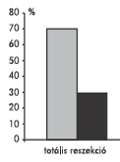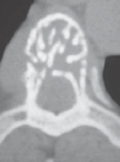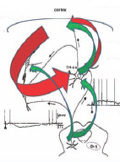The eLitMed.hu medical portal uses computer cookies for convenient operation. Detailed information can be found in the Cookie-policy.
Clinical Neuroscience - 2012;65(01-02)
Content
[Depression in neuropsychiatric diseases]
[Depression is frequently observed together with neurological disorders. Moreover this connection is bidirectional in the case of several neurological disorders, as depression can be either a comorbide syndrome or also a risk factor of them. Neurobiological background of depression involves neuroanatomical structures, their interconnected networks, disturbances of neurotransmitters, neurohormonal, neuroimmunological and neurotrophic changes, genetic background. Disfunction of these systems also plays a role in the pathogenesis of comorbid depression of neurological disorders. Interactions and clinical aspects of biological factors involved in the pathogenesis of depression in dementias, Parkinson’s disease, cerebrovascular disorders and epilepsy are discussed further. Depression as a result of neurobiological factors responsible for both neurological and psychiatric consequencies of these disorders, are often atypical as a clinical manifestation, however chracteristic for the particular neurological disorder. Evaluation of the biological backgound and clinical features of depression in neurological disorders makes the complex neuropsychiatric approach of these disorders possible.]
[The clinical relevance of 1p19q codeletion of oligodendrogliomas at the Department of Neurosurgery in Debrecen]
[Object - To determine the clinical relevance of 1p19q codeletion in case of patients treated between 2006 and 2008 with oligodendroglial tumor at the Department of Neurosurgery, University of Debrecen. Questions - Beside the traditional morphological investigations, methods of rapidly developing molecular pathology are also available for routine diagnostic procedures. Numerous studies confirm that the codeletion of the 1p and 19q alleles has a clinical relevance regarding the sensitivity for chemotherapy. In this study the connection between the 1p19q codeletion and clinical parameters was tested to evaluate the prognostic role of this genetic alteration in neurosurgical patients. Methods, clinical data - In the present study experiences about the clinical relevance of 1p19 codeletion is summarized. Between 2006 and 2008, 28 patients with brain tumor containing oligodendroglial component was tested for 1p19q codeletion. The result of the analysis was compared with clinical data such as tumor localization, extent of resection, histological grade, presence of astrocyte component, time of first recurrence, age and gender. Furthermore, the potency of 1p19q codeletion as a prognostic factor for chemosensitivity by analyzing the data of patients who underwent different treatment protocols was also evaluated. Results - Our results suggest that 1p19q codeletion can be valued as a positive prognostic factor, which is concordant with the results available in the literature. We also found positive correlation with oligodendroglial component, recurrence free survival of grade III tumors, sensitivity to chemoand radiotherapy, and inverse correlation with histological grade and age was detected. Conclusion - Though the 1p19q codeletion is currently not the part of the routine patient management, based on our study we found it appropriate for clinical use as a prognostic factor, and its predictive role in establishing oncotherapy can be also discussed.]
[The validation of the hungarian version of the Dimensional Yale-Brown Obsessive-Compulsive Scale]
[Background - The Obsessive-Compulsive disorder (OCD) has a complex phenotype, which can be summarized by using a few consistent and temporally stable symptom dimensions. The dimensional approach derived from the systematic factor analytic studies of OCD symptoms. In 2006, a new psychometric scale was created by M.C. Rosario-Campos and her colleague, the Dimensional Yale- Brown Obsessive-Compulsive Scale (DY-BOCS). This scale measures the presence and severity of obsessive-compulsive (OC) symptoms within six distinct dimensions. The Hungarian translation of the test and preliminary results were published in 2009. Purpose - The objective of this recent study was two folded: on one hand, our goal was to validate the Hungarian version of the DY-BOCS on a larger sample size. On the other hand, we wanted to publish our results gained by the Hungarian version of the test in English. Methods - We assessed 30 Hungarian patients diagnosed with OCD by DSM-IV. Reliability and validity of the expert and of the self-report were estimated. Results - Self-report and expert ratings were highly correlated. The global DY-BOCS score was well correlated with the total Yale-Brown Obsessive-Compulsive Scale score. The internal validity of the symptom dimensions and the global severity score were high. Divergent validity was also good. Conclusion - These results indicate that the Hungarian version of the DY-BOCS is a reliable and valid clinical tool.]
[Mutation analysis of alpha-galactosidase A gene in Hungarian Fabry patients]
[Aim was to detect the mutations of alpha-galactosidase A gene in two Hungarian Fabry patients. Methods - Mutation analysis was performed by polymerase chain reaction (PCR) sequencing of the seven exons and adjacent introns of the alpha-galactosidase A gene. Results - Case 1. (19 y. male patient) Mutation analysis was done for alpha-galactosidase gene, a missence mutation has been identified in the 5th exon, the aspartic acid at codon 266 has been substituted by a tyrosine (notation D266Y) due to a G-T transversion at position 10287 of the alpha GAL-A gene. Case 2. (28 y. male Fabry patient) The GAL-A mutation has been proven to be R220X mutation in exon 5 of the alpha-galactosidase A gene.]
[Gliosarcoma of the pineal region with cerebellar metastasis: case illustration]
[A very rare case of gliosarcoma of the pineal region with cerebellar metastasis is presented. A few cases of glioblastoma and fibrosarcoma have already been published however there was no reported case with gliosarcoma at the pineal region even with cerebellar metastases.]
[Rare angioproliferative tumors mimicking aggressive spinal hemangioma with epidural expansion]
[Background and purpose - We present two cases of angio-proliferative tumors that were misdiagnosed and treated as typical hemangiomas with epidural expansion. Materials and methods - Two middle-aged women presented with symptoms and radiological signs characteristic for aggressive hemangioma with epidural expansion. In the first case preoperative embolization and decompressive surgery with open transpedicular vertebroplasty was performed. Within less than a year, epidural recurrence of the tumor prompted for radical excision and corpectomy. The diagnosis after the histological studies and the further clinical evolution was metastasizing leiomyomatosis. No further recurrence occured during the next 6 years. In the second case percutaneous vertebroplasty was performed and complicated by epidural polymethyl-methacrylcate (PMMA) leakage, requiring urgent decompressive surgery. Histological study of the lesion raised the possibility of myopericytoma. This was confirmed 16 months later when complete vertebrectomy was performed due to severe epidural propagation of the recurring tumor. No further recurrence occurred in next the two years. Conclusions - Rare angio-proliferative tumors, like benign metastasizing leiomyoma and myopericytoma radiologically may resemble aggressive vertebral hemangiomas of the spine. Unlike hemangiomas, such tumors require radical removal due to their likely recurrence. As imaging studies may not be able to completely exclude such pathologies, bone biopsy and thorough histopathological studies are warranted prior to the therapeutic decision.]
[Account on the scientific meeting of Környey Society in 2011. Part 2.]
[Account on the scientific meeting of Környey Society in 2011. Part 2. 2012;65(01-02)]
[Comment on the article of Dániel Bereczki et al. “The carrier model of neurology in Hungary: A proposal for the solution until 2020”]
[Comment on the article of Dániel Bereczki et al. “The carrier model of neurology in Hungary: A proposal for the solution until 2020” 2012;65(01-02)]
1.
Clinical Neuroscience
[Headache registry in Szeged: Experiences regarding to migraine patients]2.
Clinical Neuroscience
[The new target population of stroke awareness campaign: Kindergarten students ]3.
Clinical Neuroscience
Is there any difference in mortality rates of atrial fibrillation detected before or after ischemic stroke?4.
Clinical Neuroscience
Factors influencing the level of stigma in Parkinson’s disease in western Turkey5.
Clinical Neuroscience
[The effects of demographic and clinical factors on the severity of poststroke aphasia]1.
2.
Clinical Oncology
[Pancreatic cancer: ESMO Clinical Practice Guideline for diagnosis, treatment and follow-up]3.
Clinical Oncology
[Pharmacovigilance landscape – Lessons from the past and opportunities for future]4.
5.













